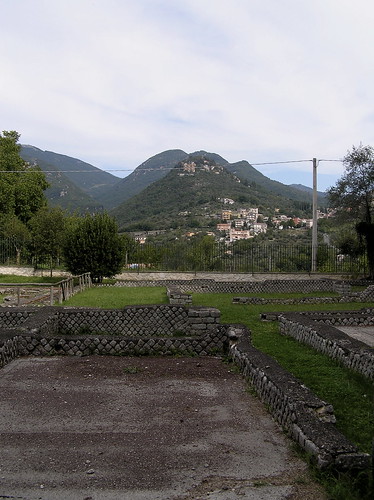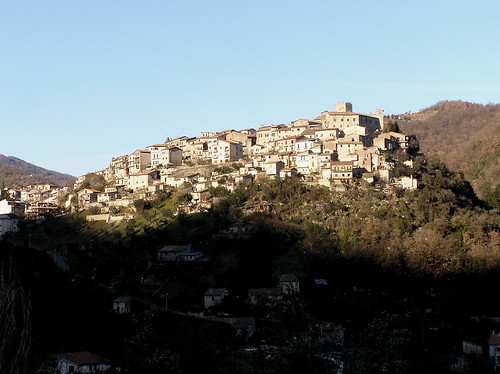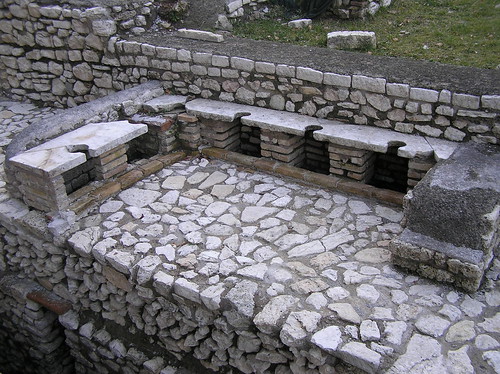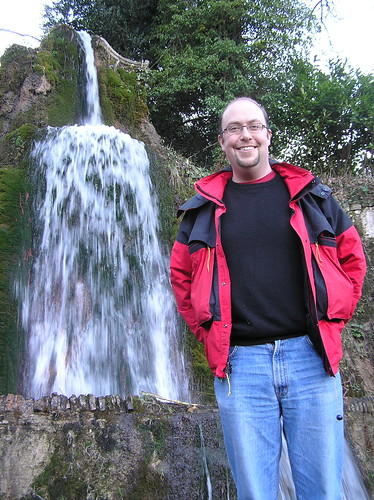la piccola villa di Orazio
Here are some photos from Horace's villa, located near the town of Licenza in the Sabine hills to the east of , right near the border of Lazio and Abruzzo. Really, though, we should give its name in scare quotes: "Horace's villa", since it's not certain that this is actually where the poet lived. The deal is, we know-- or think, or feel we know-- a whole lot about Horace's villa from his poems. He writes about it in over twenty poems, often very affectingly, describing it as an idyllic sort of place, ringed with low hills, near a river, and cool in the hot Roman summer. Here's a link to a translation (by Steven Willett) of Ode 1.17, in which he offers an invitation to come visit his villa; you can get a sense of the appeal of the place- even the gods come by in the summer!
Whether or not this particular villa belonged to Horace isn't certain (these things don't usually come with labels...) But it fits the description well and is an absolutely lovely place. Here's a shot of part of the villa-- okay, there's not much above knee-height here-- with the town of Licenza in the background:

And here's a close-up of Licenza, a typically gorgeous little Italian hill town:

As I said, there's not too much left of the villa above knee- or waist-level. But you can get a sense of it from the floor-plan:

and an axonometric view (a little small, sorry- you can click on it to see it full-sized):

The section at the top of the plan (that's to the west) is a pretty extensive bath complex. Horace may have written about the simple life that he enjoyed up in the hills, but it's clear that he basically lived like a rock star. The baths are actually the most impressive part of the architectural remains. That oval-shaped building is a laconicum, a sort of sauna that could fit at least a dozen people, but the baths extended for almost the length of the residential part of the building. Appropriately enough for the poet laureate of Rome, it comes complete with a throne:

(Here, no doubt, Horace composed his famous ode, Here I sit, broken-hearted.)
More sublime is the little fountain just up the hill from the villa. If the villa is in fact Horace's, it's hard to avoid the suggestion that this is the Fons Bandusiae: the "Spring of Bandusia" that is the subject of Ode 3.13. Here's a translation of the poem, and two terrific parodies of it, written by the Algonquin Round Table fixture, Franklin P. Adams in the 1920s).

I don't know who the goofy-looking guy blocking view is; but you can get a good view of the architectural elements around the fountain (the pool in front, concave wall behind, and structure on top), which were added by the Orsini family of Rome in the 15th century; a great example of the tendency in the Renaissance (following the same tendency among the Romans) to "fix up" nature by adding man-made details. Here they've done a great job of making the spring fit more closely to Horace's description: enclosed by hollow rocks, topped with shady trees and offering cool, clear water.
Whether or not this particular villa belonged to Horace isn't certain (these things don't usually come with labels...) But it fits the description well and is an absolutely lovely place. Here's a shot of part of the villa-- okay, there's not much above knee-height here-- with the town of Licenza in the background:

And here's a close-up of Licenza, a typically gorgeous little Italian hill town:

As I said, there's not too much left of the villa above knee- or waist-level. But you can get a sense of it from the floor-plan:

and an axonometric view (a little small, sorry- you can click on it to see it full-sized):

The section at the top of the plan (that's to the west) is a pretty extensive bath complex. Horace may have written about the simple life that he enjoyed up in the hills, but it's clear that he basically lived like a rock star. The baths are actually the most impressive part of the architectural remains. That oval-shaped building is a laconicum, a sort of sauna that could fit at least a dozen people, but the baths extended for almost the length of the residential part of the building. Appropriately enough for the poet laureate of Rome, it comes complete with a throne:

(Here, no doubt, Horace composed his famous ode, Here I sit, broken-hearted.)
More sublime is the little fountain just up the hill from the villa. If the villa is in fact Horace's, it's hard to avoid the suggestion that this is the Fons Bandusiae: the "Spring of Bandusia" that is the subject of Ode 3.13. Here's a translation of the poem, and two terrific parodies of it, written by the Algonquin Round Table fixture, Franklin P. Adams in the 1920s).

I don't know who the goofy-looking guy blocking view is; but you can get a good view of the architectural elements around the fountain (the pool in front, concave wall behind, and structure on top), which were added by the Orsini family of Rome in the 15th century; a great example of the tendency in the Renaissance (following the same tendency among the Romans) to "fix up" nature by adding man-made details. Here they've done a great job of making the spring fit more closely to Horace's description: enclosed by hollow rocks, topped with shady trees and offering cool, clear water.
0 Comments:
Post a Comment
<< Home